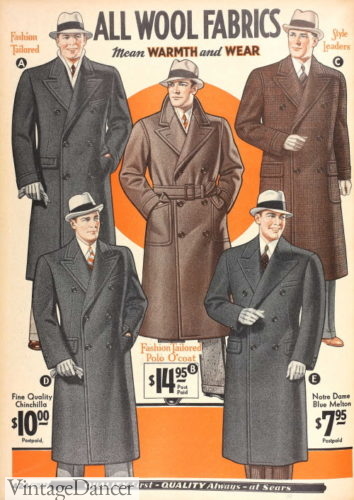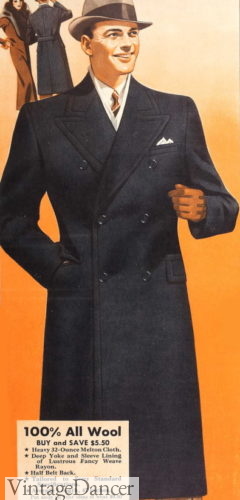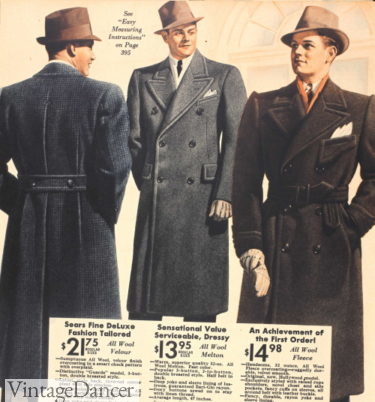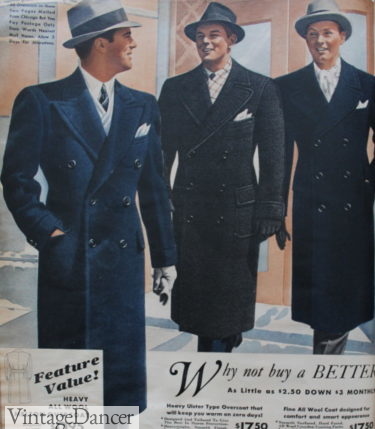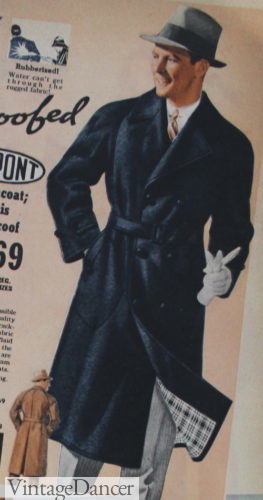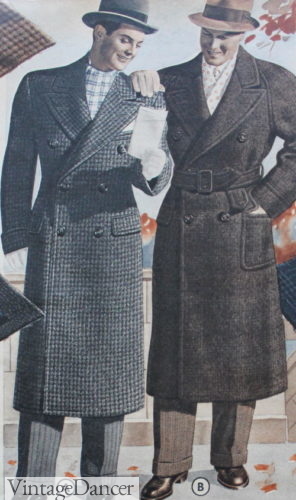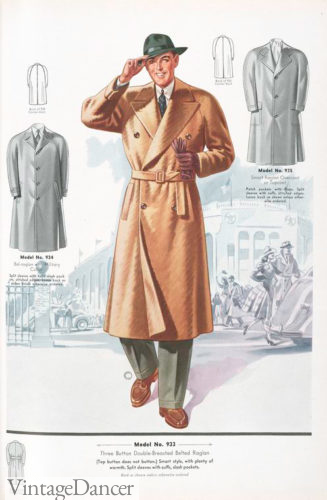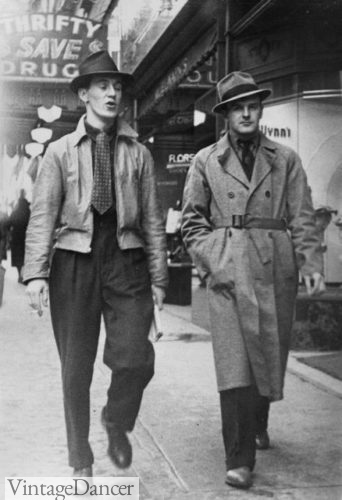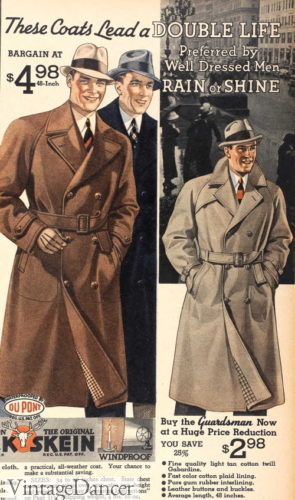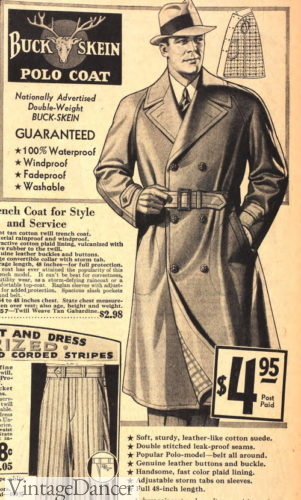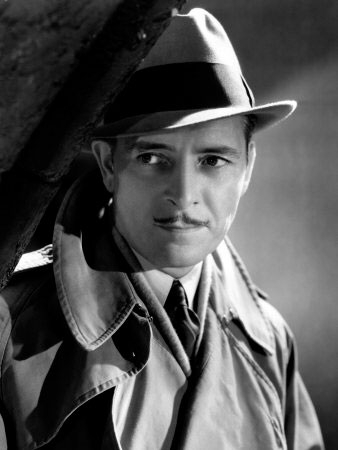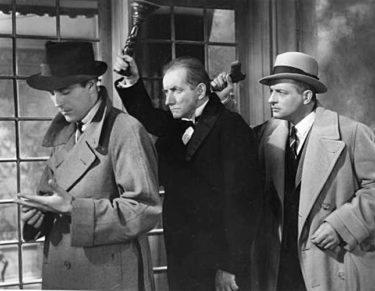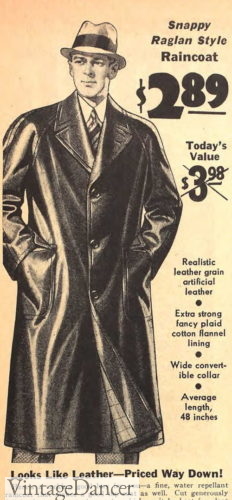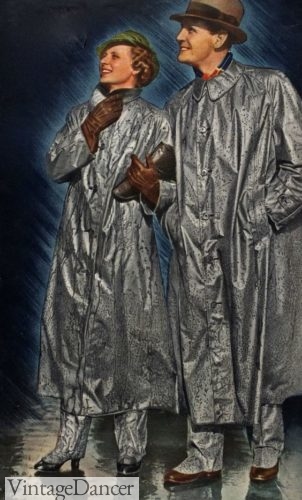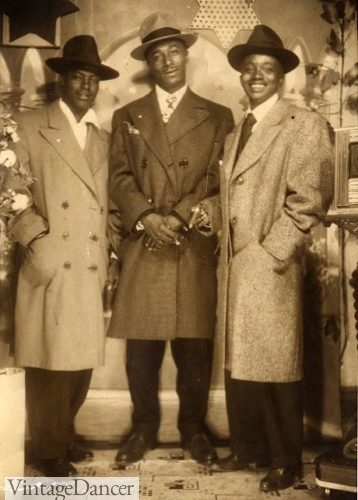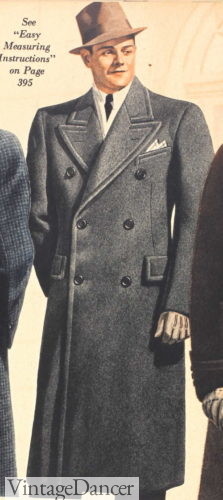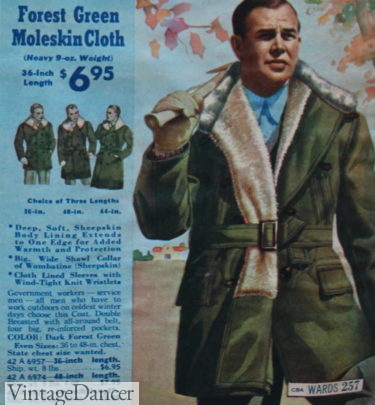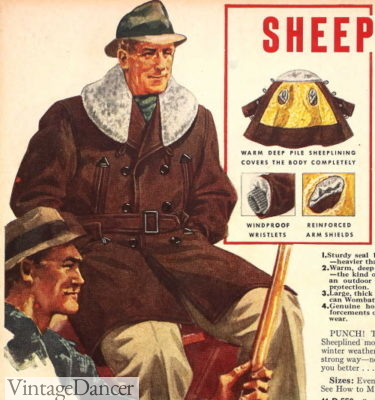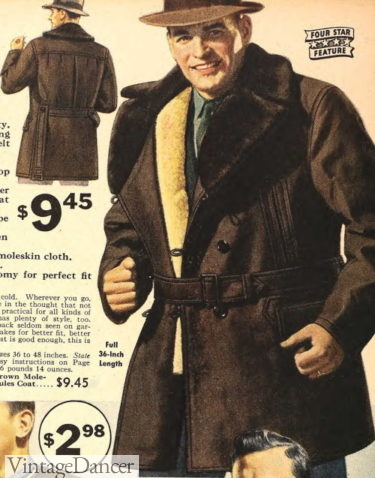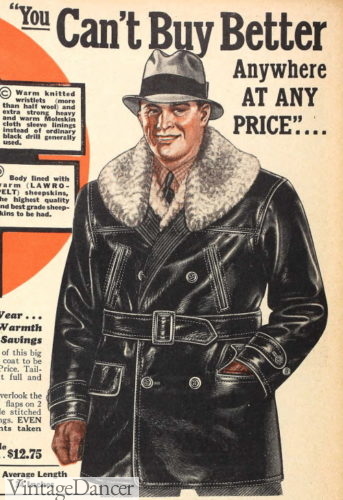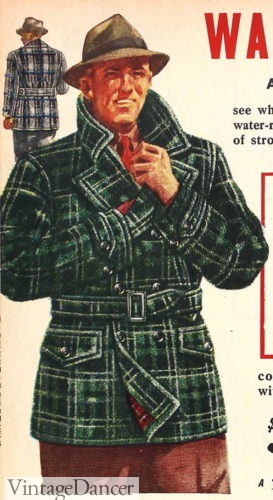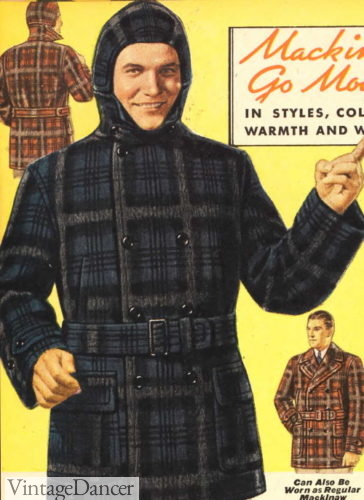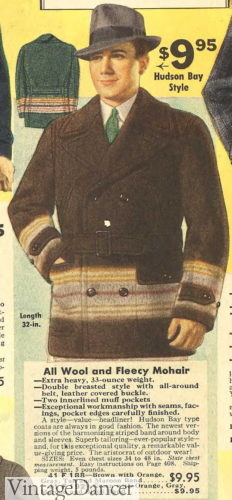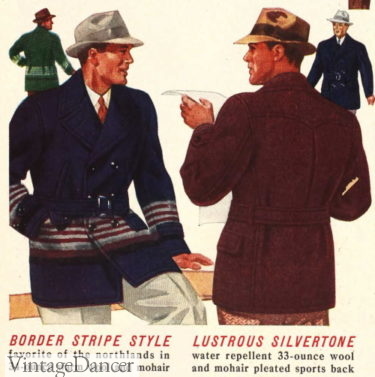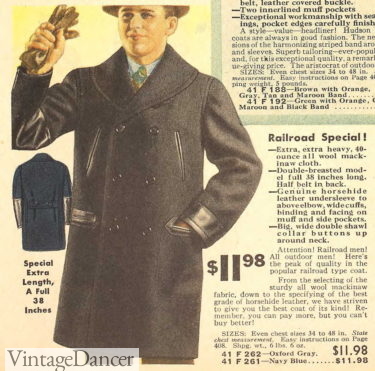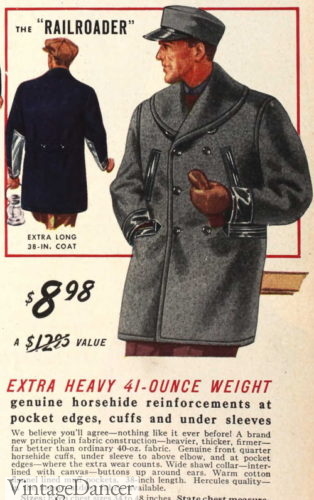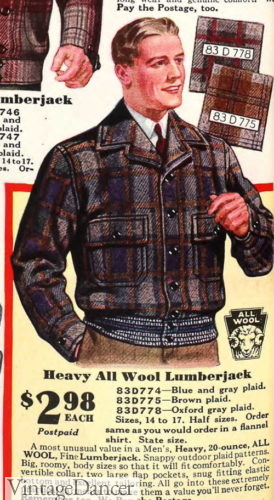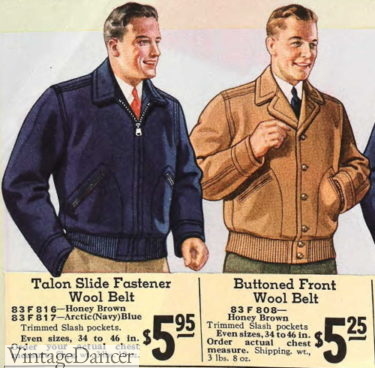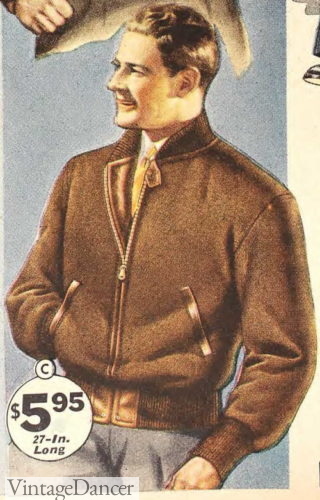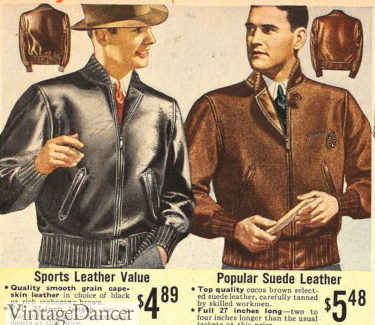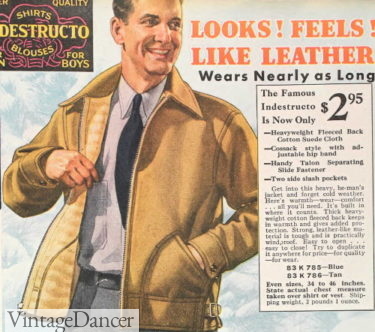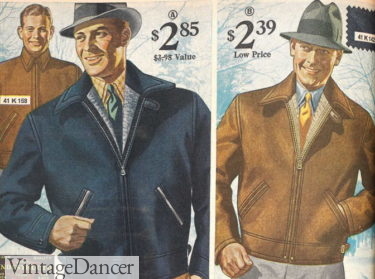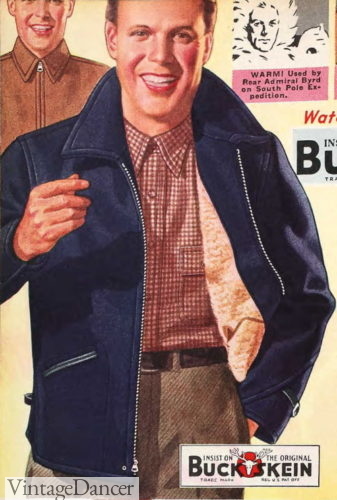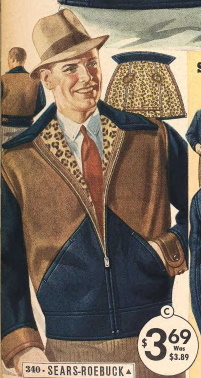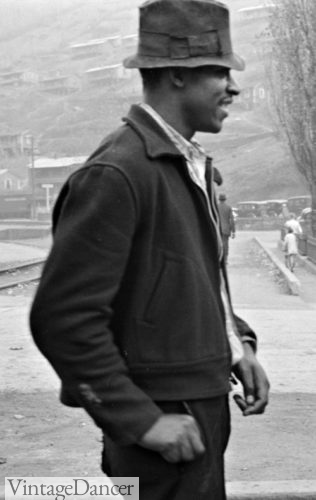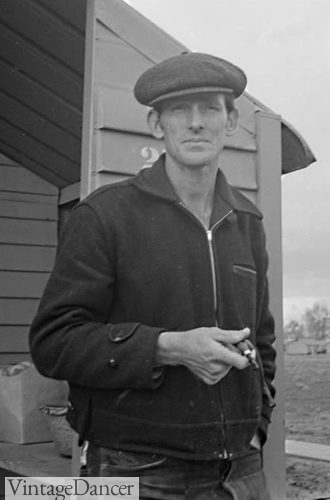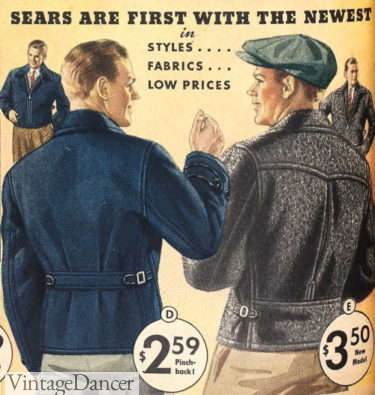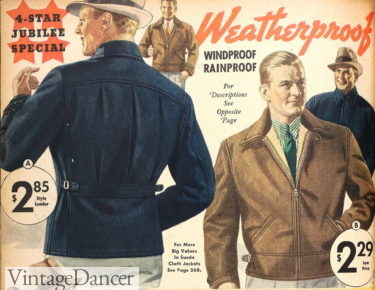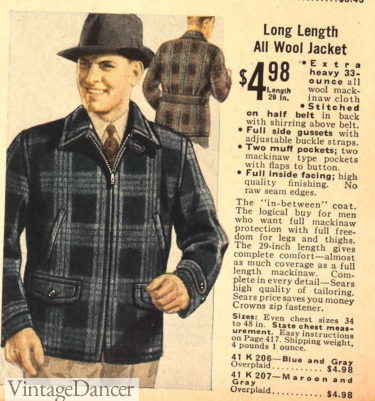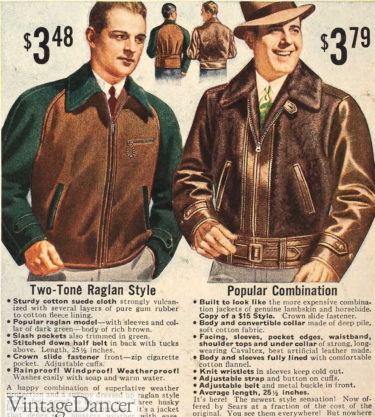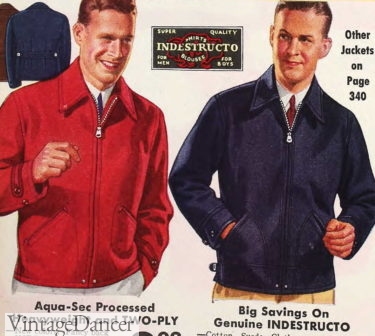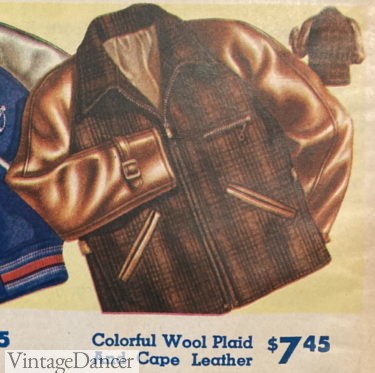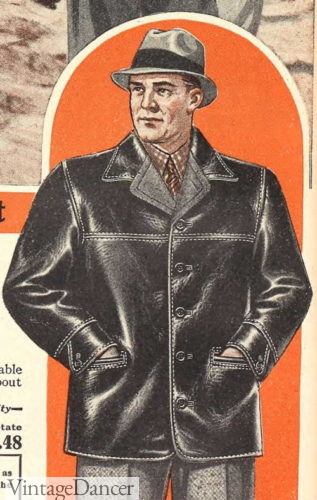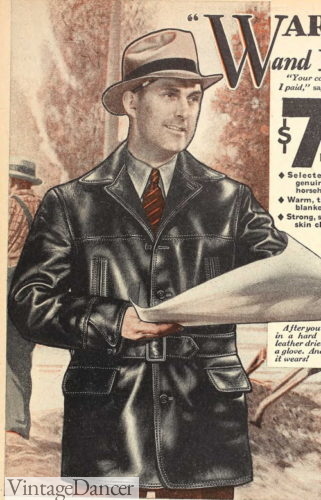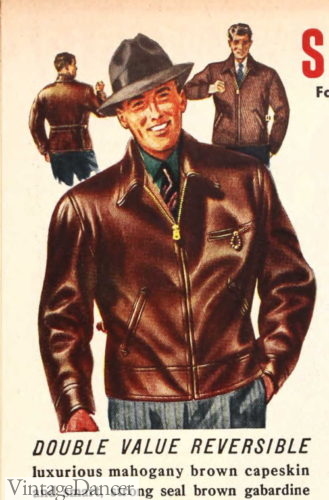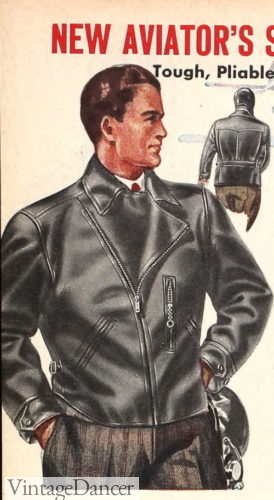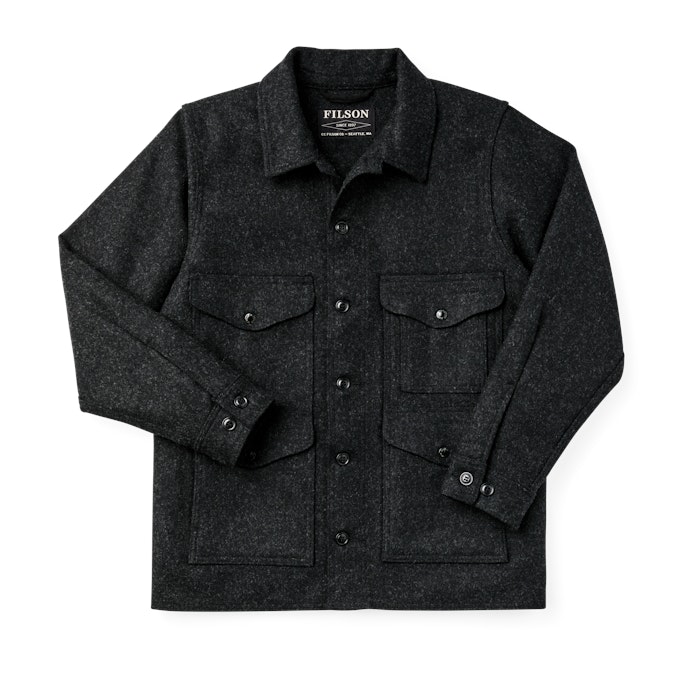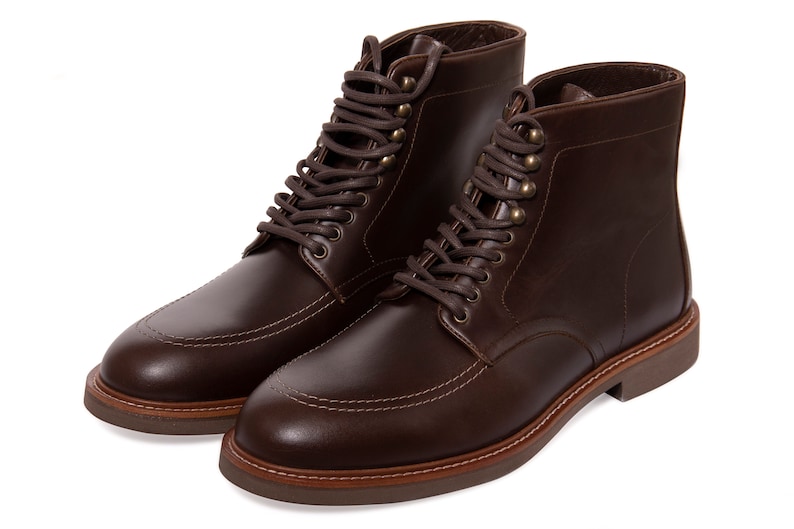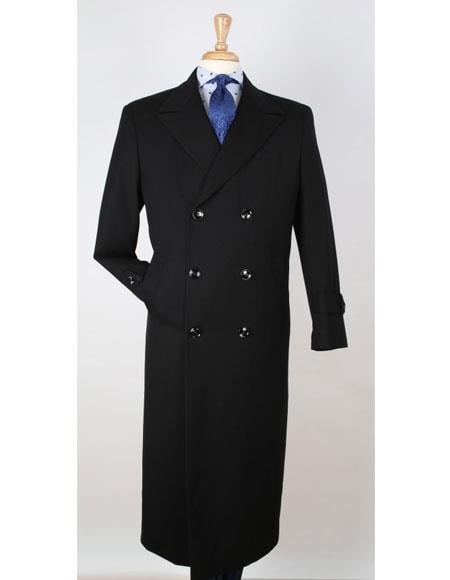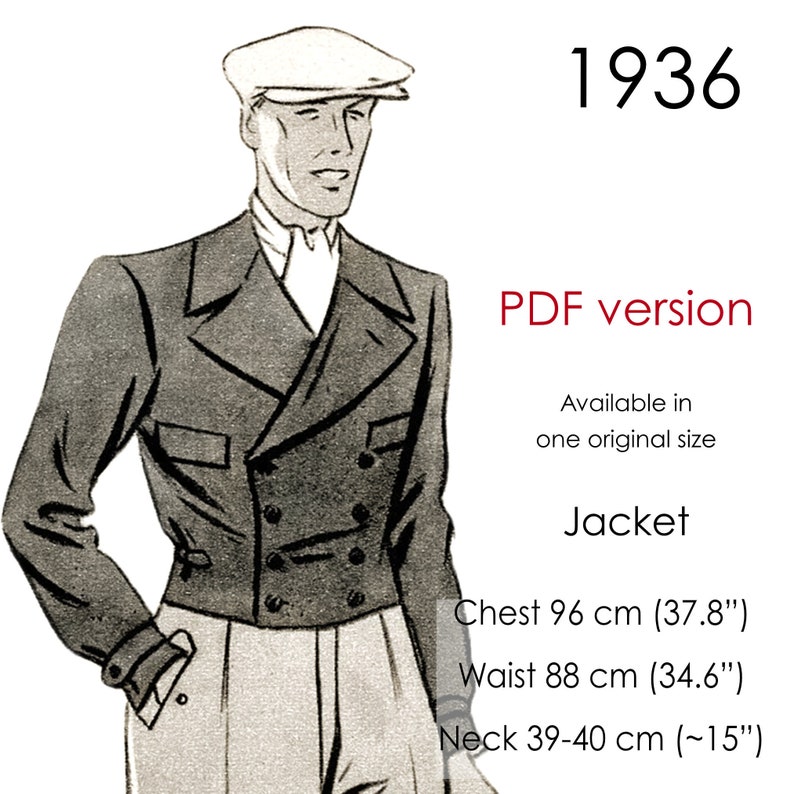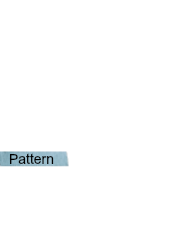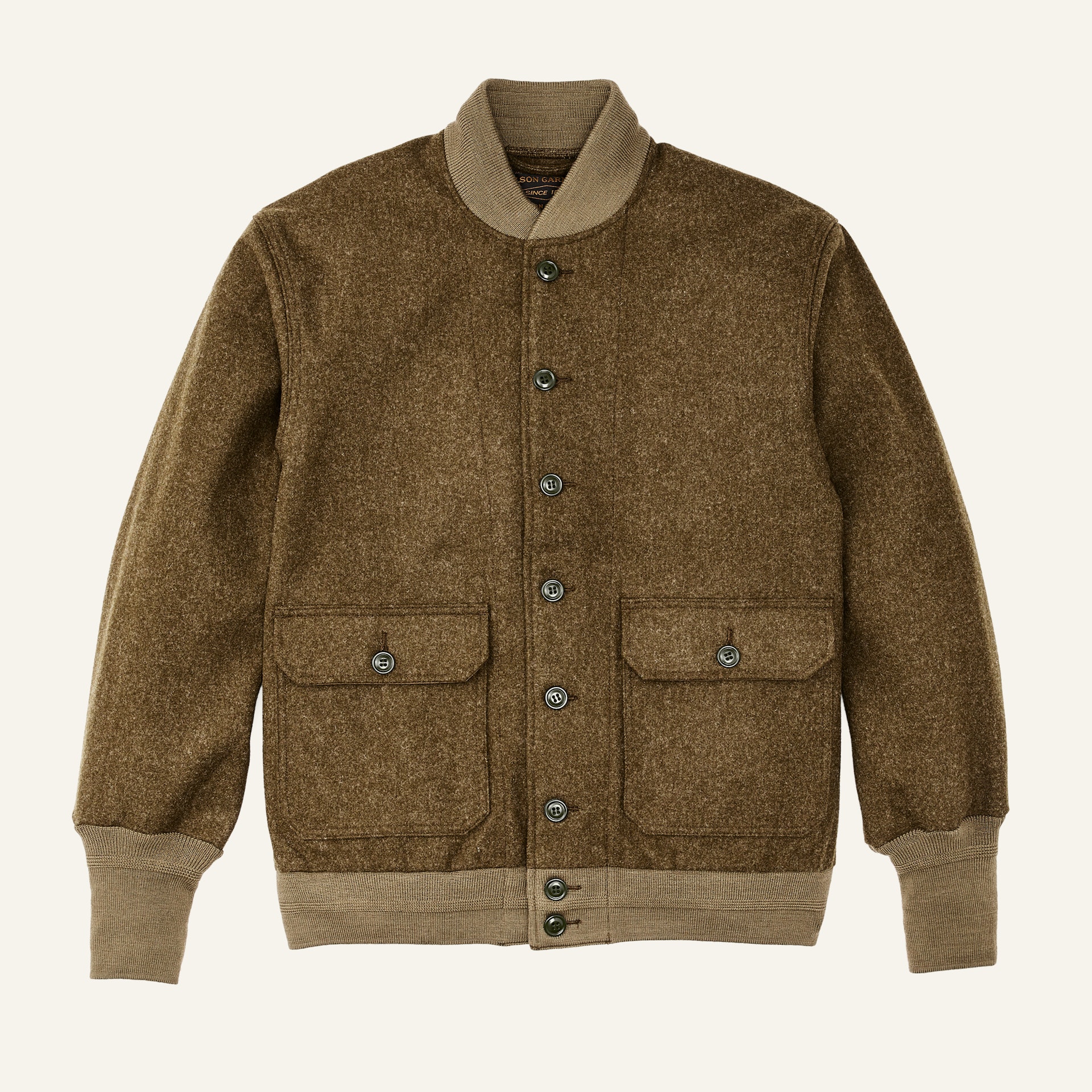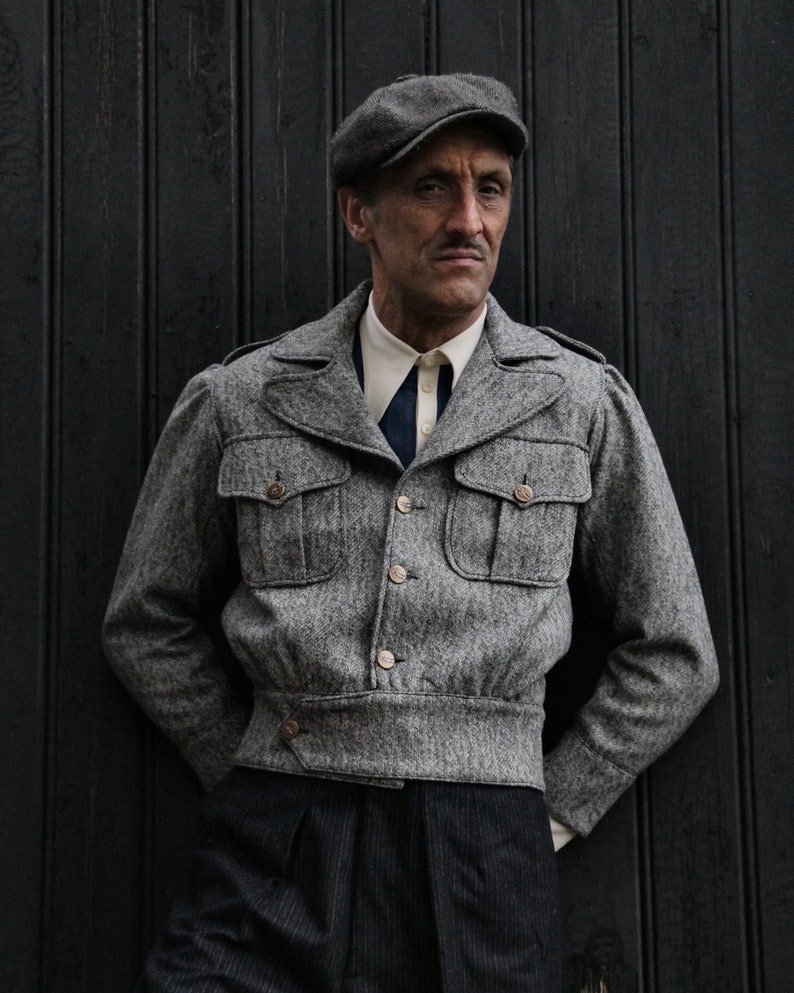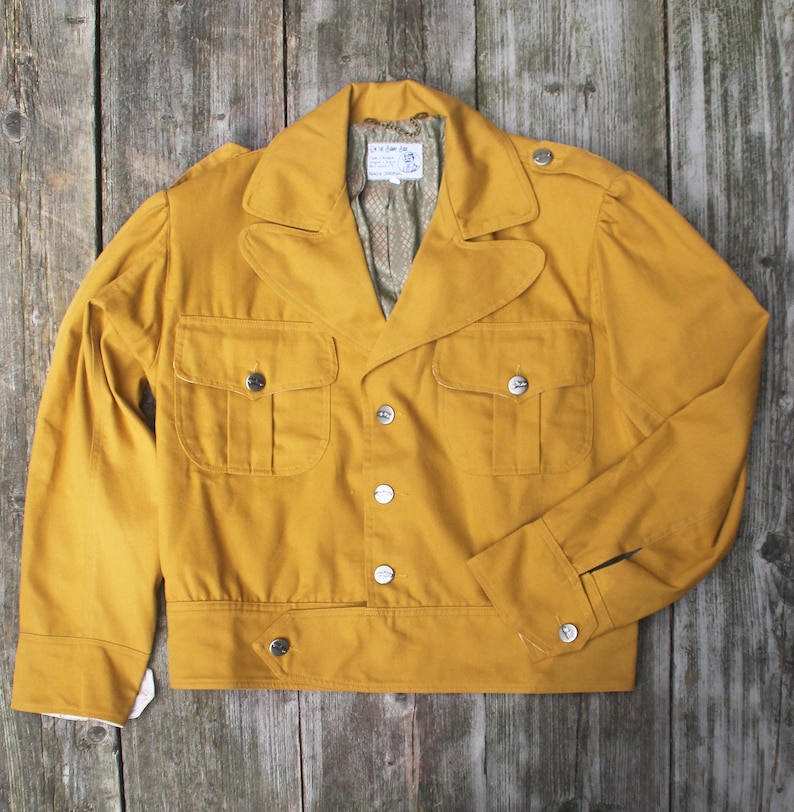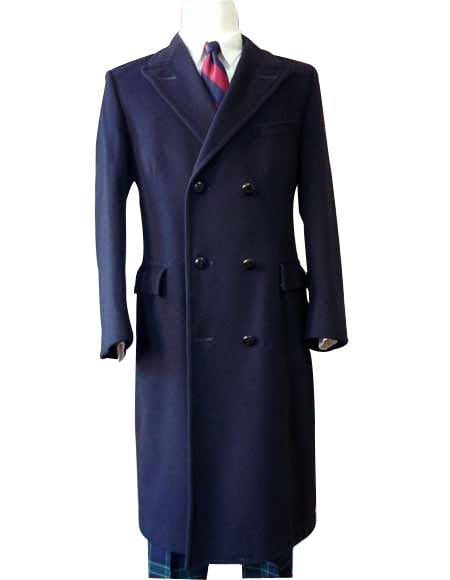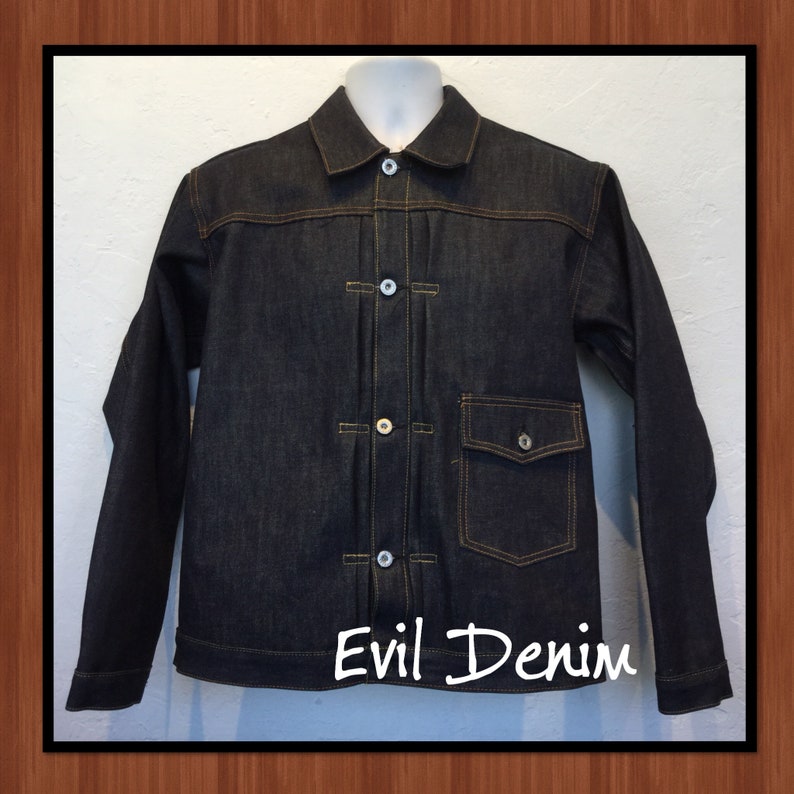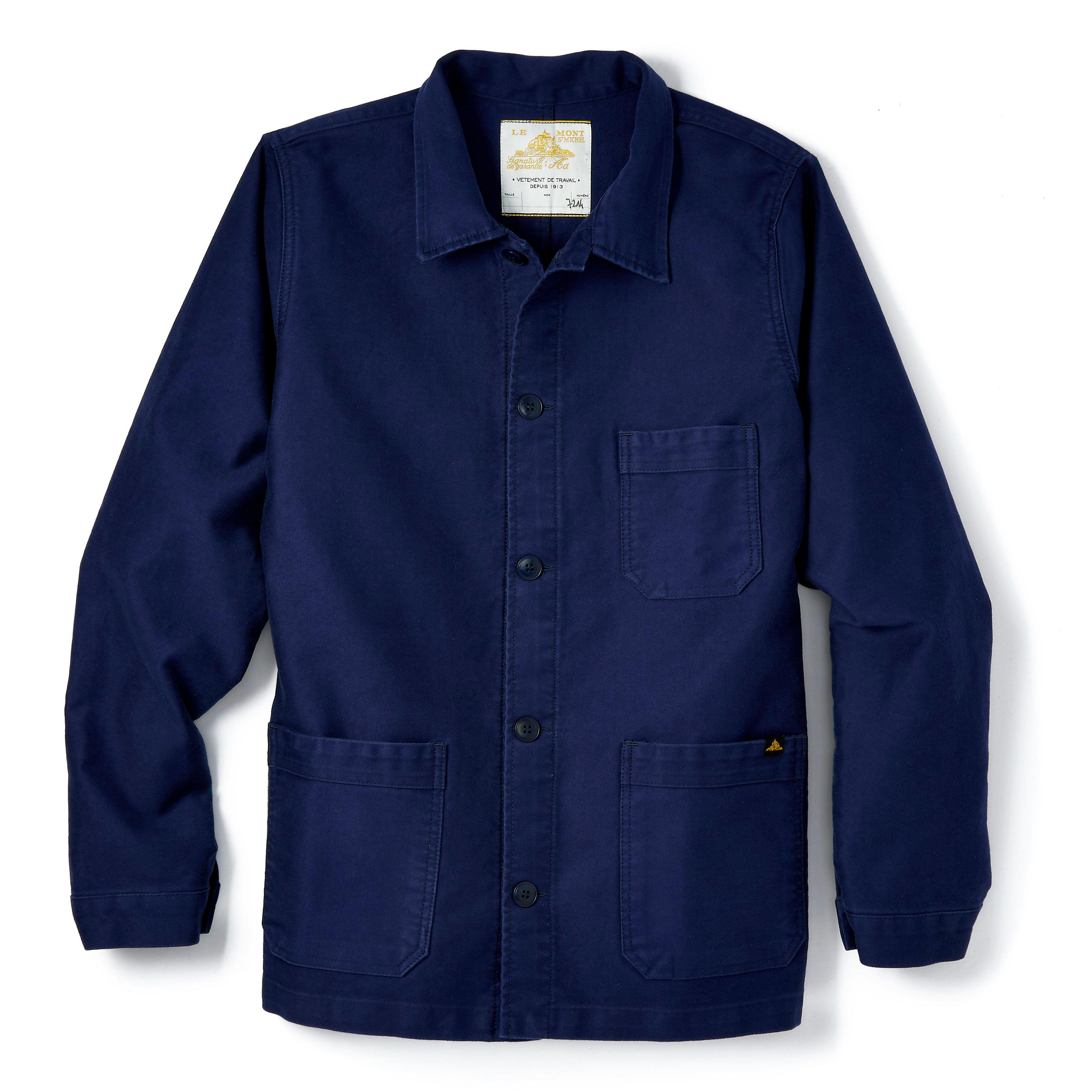The 1930s were a decade of classic masculinity. Outerwear, coats, and jackets were all designed to shape a man into a strong, dependable, and comfortable being in a time where the troubles of the Great Depression were always looming.
Men’s 1930s winter long coats took style notes from the British, while short jackets revised clothing worn by the American working classes. There was a style for every man and every class, but the lines were blurring with each passing year.
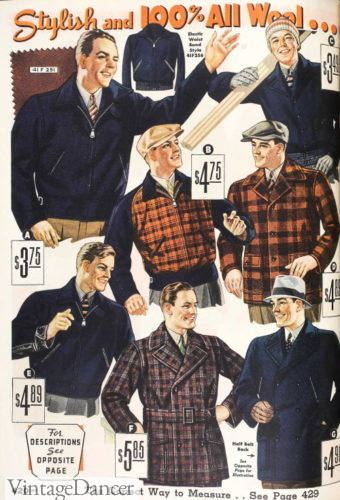
1934 Men’s Jackets
In this article, we will highlight the most common long coat, winter coat, and casual jacket styles worn by the typical middle class American male in the 1930s. At the end, we have suggestions for where to buy vintage or new 1930s men’s jackets and coats today.
1930s Overcoats
Guards Coat
Inspiration for men’s outerwear initially came from the British Grenadier’s greatcoat. The Americanized guards coat was double breasted with a shoulder line that spread past the natural shoulder to line up with the bicep. Shoulder pads helped keep the angular shape reminiscent of the ideal “Superman” silhouette.
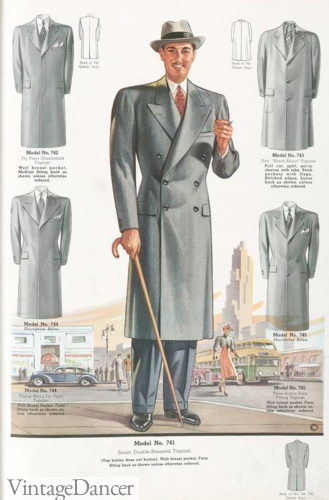
1931, The New Guardscoat, and Others
The Guards coat then angled down to the waist, creating a V roll from neck to waist with a double breasted lap. Sleeves repeated the V shape by starting out very roomy at the shoulder and narrowing down to the wrist. The widely spaced double breasted buttons had three rows, although the top buttons were spread apart further and never fastened. Side slash pockets, wide peak lapels, and two pleats on the back made this a new coat style for American men in the 1930s.
- 1932 Guards Coats (Polo in Center)
- 1934 Guard Coat of Navy Blue Wool
British men’s coats were slightly different. At the back they had one inverted pleat from collar to hem, while the American version had two inverted pleats — one from the shoulderblades to waist and the other from waist to hem.
- 1937 Coat Back, Guards Coat, Polo Coat
- 1938 Guards Style Coats
The most in demand topcoat colors were blue chinchilla wool, Melton wool, fleeced wool, and blue cheviot in spring. Dark brown, classic grey, camel, and black were also in style.
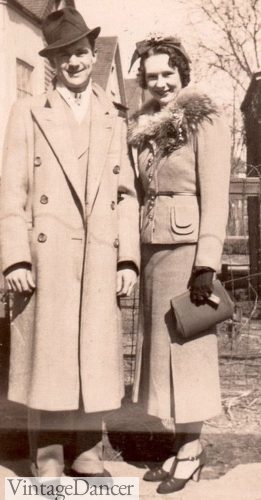
1937 Wearing a Guard’s Coat Unbuttoned
Polo Coat
A Guards coat with a matching thick belt changes it into the “‘Polo Coat.” Many men preferred the slimming effect of the belted waist, which also accented the broad shoulders. The double breasted buttons stacked evenly, and the cuffs were turned back for extra bulk.
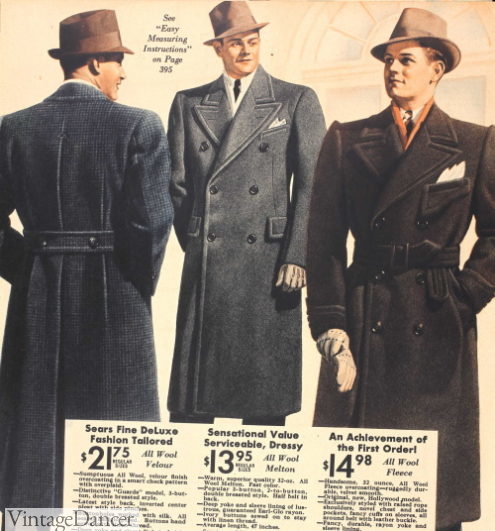
1937 Guards Coat in Middle, Polo Coat on Right
Polo coats could also feature a wrap around belt style, sometimes without front buttons. The wrap-over polo was one of the few coats to come out of Hollywood instead of Britain. It was shorter in length and the tie wrapped loosely off center. A bellows pleat back, pleated full skirt, three belt loops, and an oversized collar flipped up around the neck made the details. The wealthy young man was the target market for this “Swanky” new coat.
Polo coats could be any color, although the tan camel hair or blended llama hair cloth is the most iconic.
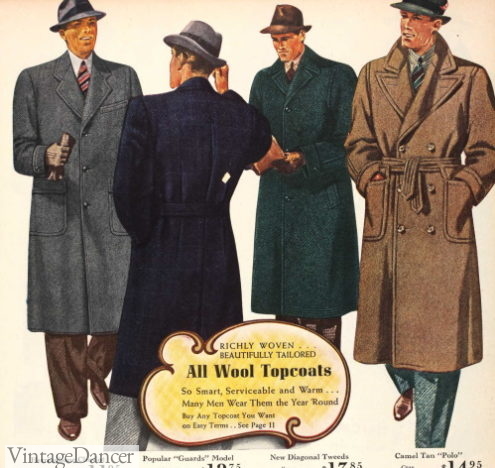
1939 City Coat, Guards Coat, Tweed City Coat, Wrap Belt Polo Coat
The ‘polo coat’ name has changed meanings a few times. It is used most often today to refer to a camel hair color topcoat, with or without a belt.
Raglan Sleeve Coat
The raglan sleeve coat in both single and double-breasted designs became very popular in the mid-1930s. Solid colors such as navy blue, grey, brown, and tan lined in printed fabric. Glen plaid, plaid over plaid, windowpane checks, and herringbone were on trend in the later half of the 1930s.
The collar was less peaked than the Guards coat. It also had a back with inverted pleats and a scalloped yoke.
- 1938 Raglan Sleeve Polo Coat
- 1938 Inset and Raglan Sleeve Coats
In winter, the rich could afford fur lining with matching fur collars and lapels, although many furs were the cheaper rabbit skin instead of exotic pelts.
Trench Coat
The rain proof trench coat was especially popular with raglan sleeves. Detectives solved crimes wearing a tan, green, or yellow (Dick Tracy) trench coat made of rubberized cotton or gabardine. The lightweight belted waist and large collars fit perfectly into the tough guy image of the thirties.
- 1930s Tan Trench Coat
- Streetwear with a Trench Coat (R)
- 1935 Trench Coats
- 1933 Trench Coat with Raglan Sleeve
- Bulldog Drummond
- Bulldog Drummond
Rain Slicker
Most men walking in mild to moderate rain found the trench coat offered plenty of protection from the elements. Others, however, needed a full rubberized rain slicker to keep dry. They came in dark green, dark blue, grey, black, or bright yellow. They could have raglan sleeves, two side slash pockets, and either a peaked collar or round button-up collar.
For working outdoors, there were even sturdier oil cloth coats and pants, tall rainboots, specialized hats, and gloves. See more about 1930s workwear here.
- 1934 Rain Slicker
- 1938 Grey Rain Slickers
1930s Short Coats
Fingertip length coats, popular in the 1920s, continued to be well loved by young men in the 1930s. Although not as common as full length coats, the short coat made in lighter weight wools, tweed, and even cotton were popular on college campuses, where dashing from one building to the next required less protection.
For Sears, the single breasted version was called a “City Coat.” They were slow to catch on in the mainstream until the 1940s.
- Shorter Lengths in Lighter Wool for These Three Fine Dressers
- 1937 Short Coat
1930s Lined Coats
The heavy shearing lined winter coat that was popular in the 1920s continued to be a favorite in the 1930s. It lost some favor with the mainstream as a fashion piece, but continued to be a strong workwear coat. Some occupational uniforms, such as motorcycle policemen, wore the leather shearling coat in winter.
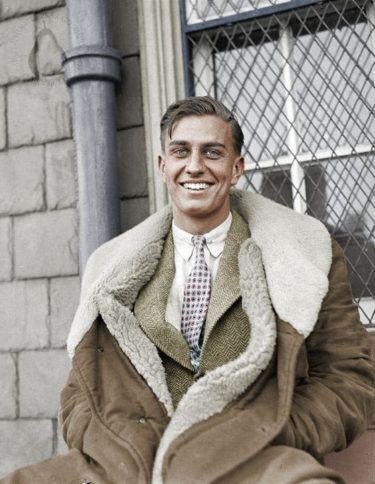
Franklin D. Roosevelt Jr wearing a shearling coat
The outer fabric was a weather-proof moleskin, sheepskin, hide leather, or even corduroy. Inside was thick shearling wool. Collars could match the inner shearling or be a real or faux soft fur.
- 1938 Moleskin
- 1939 Sheepskin
- 1937 Sheepskin
- 1936 Leather Outer with Shearling Inner
Mackinaw Coat
The other 1920s carry over was the plaid mackinaw cloth coat. It was a favorite with sporting men in the great outdoors. Both neutral and very bright plaids were popular in shades of blue, green, brown, black, and rusty-red.
The Talon zipper replaced buttons on a few mid ’30s and later models, but the love of the classic button-up held out. Some mackinaw jackets were sold with a detachable hood.
- 1939 Green Plaid Mackinaw
- 1937 Blue Plaid Mackinaw with Hood
The one unique pattern of 1930s Mackinaw coats was The Hudson’s Bay blanket coat. It had a wide stripe pattern below the belt (or all over, sleeves, etc). The cloth was an extra heavy 33 ounce wool. First made in Canada, tourists brought them back, having found them incredibly warm and durable — not to mention stylish. They were sold by high end outdoor retailers and then copied into cheaper cloths by Sears and similar retail brands.
Find vintage Mackinaw coats for sale here.
- 1937 Hudson Bay Stripe Mackinaw
- 1939 “Hudson Stripe” and Plain Brown Mackinaw Coats
Railroader Coat
At the end of the decade, a new longer mackinaw coat, dubbed “the railroader,” came into fashion. It was now 38 inches long, with a shawl collar and no front belt. It had leather reinforced pockets, cuffs, and undersleeve, making it one of the strongest and most durable short coats of the decade.
- 1937 Railroader Jacket
- 1939 Railroader Jacket
1930s Men’s Jackets
Moving down in length, we come to casual jackets. The 1930s are well known for their short jacket styles.
Bush Coat
The bush coat, named after its popularity with travelers on African Safari, was a khaki cotton drill coat (or short sleeve shirt) with four large bellows pockets on the chest and waist, a fold out shirt collar, and a belted waist. These light yet durable jackets made their way to America among well-to-do eccentrics and Hollywood types. Khaki tan is the more noteworthy color, although brown and olive green were also available.
Today, in 2021, the bush jacket is experiencing a revival.
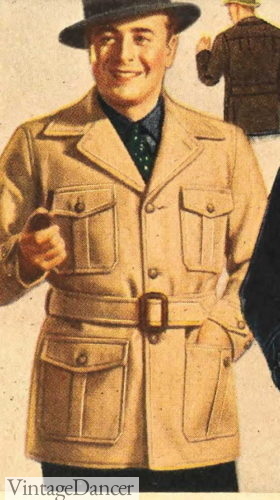
1938 Bush Jacket
Lumberjack Jackets
The 1920s plaid shirt-jacket (shacket?), called a windbreaker or Lumberjack, carried on into the 1930s, although it was given a new style name. Now called the “blouse” style jacket, it featured a ribbed waistband, button front, side slash pockets (a change from two front pockets), and a notch collar. The ribbed knit waistband gave it a blousy effect, especially when made of lighter summerweight fabrics and suede. Heavy mackinaw cloth and leather were other, stronger materials, often used for outdoor wear.
- 1931 Heavy Wool Plaid Lumberjack Jackets
- 1934 Lumberjack Style Jackets
One variation replaced the stiff collar with a soft knit band. These would later become “Bomber” jackets. In the 1930s, they were simply blouse style jackets with a matching ribbed waistband and two flap pockets. They were usually made of leather or suede in black or brown.
- 1936 Suede “Blouse Jacket
- 1938 Leather and Suede Blouse Jackets
The two tone jacket used the “blouse jacket” style to create a varsity/collegiate/school sport team jacket in the late 1930s. Two tone sleeve and body jackets had been around for most of the 1930s, but it wasn’t until the end of the decade that the blouse style was becoming standard apparel. A wool body with leather sleeves allowed the colors to be customized to the team/school. Who knew that this style would last well into the 21s century!
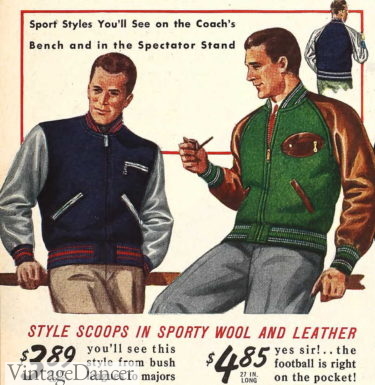
1939 Team Jackets
Cossack Jacket
The lumberjack was replaced by the Cossack jacket, which removed the knit band. Instead, it had a flat front with slide buckles on the waist and sleeves to tighten it to the body. Most had a zipper instead of buttons. Two slash pockets, sometimes outlined in stitching, are the other notable details. The length was only 27 inches, which overlapped high waist trousers.
- 1935 Moleskein Cloth Cossack Jacket
- 1935 Cossack Jackets
- 1936 Shearling Lined Cossack Jacket
- 1936 Two Tone Cossack Jacket
Cossacks were for every man, from laborer to wealthy weekender. They could be made in strong leather, suede, wool cloth, Moleskin, corduroy, or softer gabardine in summer. Winter jackets were frequently lined in shearling wool, fur, faux fur, or flannel. A small cigarette chest pocket was added in the mid 1930s.
Learn more about 1930s working class clothing.
- 1935 Side View of a Cossack Jacket
- 1935, Worker, Wearing a Cossack Jacket
What makes Cossack jackets, and all 1930s jackets, collectable today is the unique back treatments. Pleating, gathers, inverts, scallop, half belts… You name it, it came on a 1930s jacket.
- 1936 Half Belt and Inverted Pleat Back
- 1936 Half Belt and Pleated Back
The name “Cossack” became synonymous with any kind of casual short waisted jacket in the 1930s. Designers began to experiment with collar types, back treatments, adding/removing buckles, various fabrics, large and small prints, pockets, and zippers. Bit by bit, the traditional Cossack began to change. These are just a few of the variations:
- Plaid Mackinaw Cloth Cossack with Two Flap Pockets
- Raglan Two Tone Cossack, and Leather Buckle Belt Cossack
- 1936 Men’s Cossack Hybrid Jackets
Leather Jackets
The final category of jacket is the all-leather casual jacket. Like the Cossack, designers had fun coming up with a plethora of pockets, zippers, top stitching, back belts, and suede/leather combinations. Some made existing styles out of leather (Cossack, Blouse, Mackinaw), while new designs were taking inspiration from the military, auto racing, and aviation uses. These are a few examples:
- 1936 Basic Leather Jacket
- 1936 Belted Mackinaw Style Leather Jacket
- 1939 Cossack Style Leather Jacket
- 1939 Aviator Style Leather Jacket
1930s Coats and Jackets to Buy
- Genuine vintage is best but rare and expensive. Try our vintage search tool to scan Etsy, eBay and others.
- Reproduction 1930s clothing brands will sometimes include coats and jackets in their winter lines. See our list of recommended brands here.
- Vintage inspired 30s jackets and coats, come and go every season. See the ones we found below or browse all decades of vintage outerwear here.
Debbie Sessions has been teaching fashion history and helping people dress for vintage themed events since 2009. She has turned a hobby into VintageDancer.com with hundreds of well researched articles and hand picked links to vintage inspired clothing online. She aims to make dressing accurately (or not) an affordable option for all. Oh, and she dances too.
